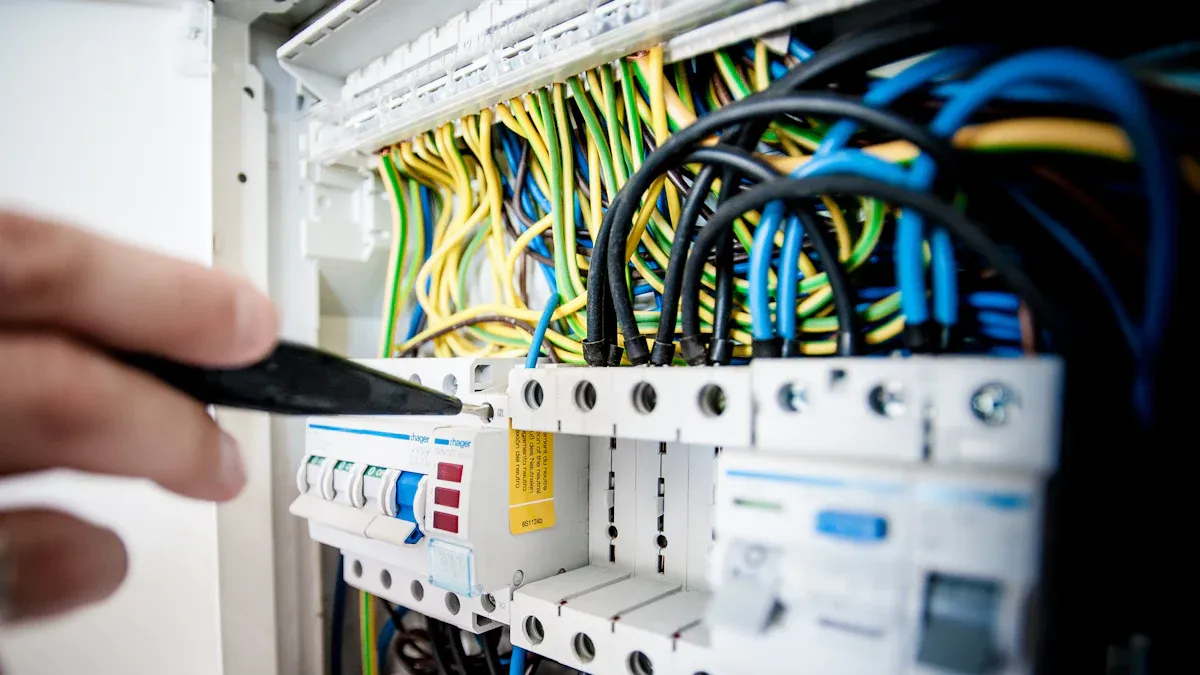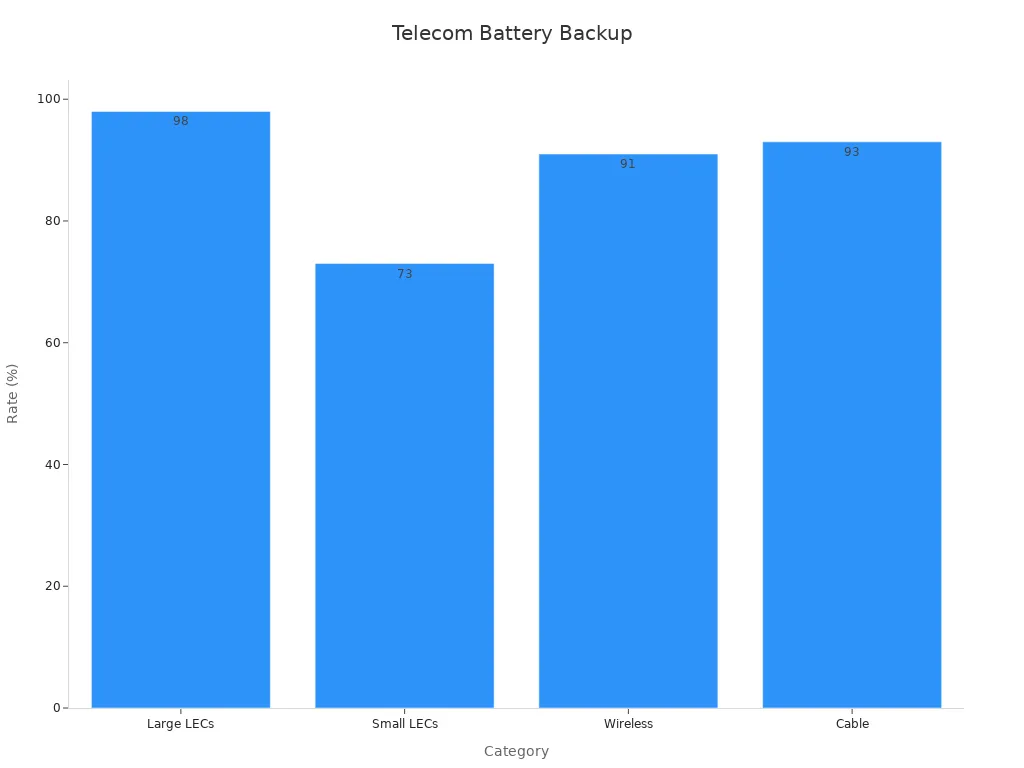How to Choose and Install Telecom Battery Backup Systems in 2025

To choose and install telecom battery backup systems in 2025, you must focus on correct sizing, battery type selection, and regulatory compliance to ensure reliable network operation. Power disruptions cause nearly 70% of telecom outages, and 90% of operators view backup power as critical. The table below shows why your choices matter:
Statistic / Data Point | Value / Description |
|---|---|
Percentage of telecom operators viewing backup power as critical | 90% |
Percentage of telecom outages caused by power disruptions | Nearly 70% |
Energy capacity advantage of lithium-ion batteries over lead-acid | Up to 3 times higher in smaller footprint |
Operational cost reduction via smart battery management systems | Up to 30% |
You should plan for current and future power needs. Network expansion, 5G growth, and sustainability targets demand scalable, efficient, and compliant backup power solutions.
Key Takeaways
Choose lithium-ion batteries for their high energy density, long life, and low maintenance to ensure reliable backup power.
Calculate your total power needs carefully and size your battery system with a 20% safety margin to handle future growth and unexpected demands.
Follow safety regulations and site assessments during installation to protect equipment and personnel while ensuring system longevity.
Use smart monitoring systems to track battery health in real time, catch problems early, and reduce maintenance costs.
Perform regular inspections and annual load tests to maintain backup system reliability and avoid unexpected outages.
Overview of Telecom Battery Backup Systems
Purpose and Components
You rely on telecom battery backup systems to keep your network running during power outages. These systems act as a safety net, providing uninterrupted power to critical telecom equipment. When the main power fails, the backup system instantly takes over, preventing service interruptions and equipment damage.
The main components include:
Batteries: Store energy for use during outages. Lithium-ion, lead-acid, and nickel-cadmium batteries are common choices.
Uninterruptible Power Supply (UPS): Switches to battery power automatically and regulates voltage.
Monitoring Systems: Track battery health, temperature, and charge status. Smart monitoring helps you predict issues before they cause failures.
High-capacity batteries ensure continuous telecom service, even in harsh environments. Safety features like overcharge protection and temperature control extend battery life and reduce risks. Low maintenance needs help you save on operational costs.
Battery Type | Energy Density (Wh/kg) | Cycle Life (cycles) | Maintenance | Key Benefits |
|---|---|---|---|---|
Lithium-Ion | Up to 3000 | Low | High energy density, long lifespan, rapid charging, compact size | |
Lead-Acid (VRLA) | 20–40 | <350 | Moderate | Lower upfront cost, but shorter lifespan and higher maintenance |
Nickel-Cadmium | 40–60 | Around 2000 | High | Moderate durability and cost |
Key Terms
Understanding a few key terms helps you choose the right telecom battery backup systems:
Capacity: The amount of electric charge a battery can store, measured in ampere-hours (Ah). For example, lithium-ion batteries range from 1.5 Ah (small cells) to over 200 Ah (large cells).
Depth of Discharge (DoD): The percentage of battery capacity used. Frequent deep discharges shorten battery life.
Efficiency: The ratio of energy output to input. Lithium-ion batteries offer nearly 100% efficiency, making them ideal for telecom use.
State of Charge (SOC): Shows how much charge remains in the battery, expressed as a percentage.
Energy Density: The amount of energy stored per unit weight or volume. Higher energy density means more power in less space.
You should look for batteries with high energy density, long cycle life, and strong safety features. These qualities ensure your telecom battery backup systems deliver reliable performance and lower your total cost of ownership.
Sizing Telecom Battery Backup Systems

Assessing Power Needs
Start by calculating the total power requirement for your telecom site. List every device that needs backup, such as routers, switches, and base stations. Check each device’s power rating, usually found on the equipment label or datasheet. Multiply the power rating (in watts) by the expected run-time (in hours) to get the watt-hours (Wh) needed.
For example:
If you have a router (50W) and a switch (30W) and want 8 hours of backup:
Total load = (50W + 30W) × 8h = 640Wh
You can also convert watt-hours to ampere-hours (Ah) if your battery is rated in Ah:
Ampere-hours (Ah) = Watt-hours (Wh) ÷ System Voltage (V)
Tip: Always include a safety margin of at least 20% to account for unexpected surges or future equipment.
Battery Types
Choose the right battery technology for your telecom battery backup systems. The most common options are lead-acid and lithium-ion batteries. Lithium-ion batteries offer higher energy density, longer cycle life, and faster charging. Lead-acid batteries cost less upfront but require more maintenance and have a shorter lifespan.
Battery Type | Energy Density | Cycle Life | Maintenance | Charging Time |
|---|---|---|---|---|
Lithium-Ion | High | 5,000+ cycles | Low | 2-3 hours |
Lead-Acid (VRLA) | Low | <350 cycles | Moderate | 8-10 hours |
Lithium-ion batteries handle deeper discharges without rapid degradation. Cycling tests show that lithium chemistries like NCA, NMC, and LFP maintain capacity even at higher depths of discharge. These batteries also benefit from advanced battery management systems (BMS) that monitor temperature and charge, improving safety and performance.
Capacity and DoD
Select a battery with enough capacity to meet your calculated load. Industry best practice recommends sizing your initial battery capacity at 125% of your total load. This approach ensures you have a buffer for unexpected demand or battery aging.
Depth of Discharge (DoD) measures how much of the battery’s capacity you use during each cycle. Lithium-ion batteries can safely operate at up to 80-90% DoD, while lead-acid batteries should stay below 50% DoD to avoid rapid wear. Empirical studies show that deeper discharges in lithium batteries do not significantly reduce their lifespan, especially when managed by a BMS. In contrast, lead-acid batteries degrade quickly if discharged too deeply.
Note: Always check the manufacturer’s recommended DoD for your chosen battery type. Using the correct DoD extends battery life and reduces replacement costs.
Planning for Growth
Plan for future expansion when sizing telecom battery backup systems. Network traffic and connected devices will increase as your operations grow. You should oversize your battery system to accommodate new equipment and longer run-times.
Capacity planning helps you handle more devices and higher data loads.
Redundancy and failover mechanisms ensure your network stays online during faults.
Load balancing distributes power evenly, preventing overloads.
Emerging technologies like software-defined networking (SDN) and network function virtualization (NFV) allow you to scale resources dynamically.
Cloud-based solutions offer flexibility, letting you add backup capacity without major hardware upgrades.
Market forecasts for telecom infrastructure show steady growth through 2032. Align your backup system with these trends to avoid costly upgrades later. Regular monitoring and collaboration with network professionals help you anticipate and manage future demands.
Professional consultation ensures you select the optimal size and configuration for your telecom battery backup systems. Experts can help you navigate technical requirements, compliance, and integration with existing infrastructure.
Installation Steps
Site Assessment
Begin your installation by evaluating the site environment. You must check temperature and humidity levels, as batteries perform best within manufacturer-recommended ranges. High temperatures accelerate battery aging, while excessive humidity can cause corrosion and electrical faults. Use a thermometer and hygrometer to record baseline conditions.
Prepare the site by clearing debris and ensuring proper ventilation. Place equipment away from direct sunlight, water sources, and dust-prone areas. Design the layout to allow easy access for maintenance and monitoring. Weather-resistant enclosures protect outdoor installations from rain, wind, and extreme temperatures.
Tip: Always verify that your site supports the weight and footprint of the battery racks and UPS units. Reinforce flooring if necessary.
Compliance and Safety
You must comply with all relevant regulations and safety standards during installation. The Occupational Safety and Health Administration (OSHA) regulation 1910.268 specifically addresses telecommunications spaces. This standard covers installation, operation, maintenance, and removal of telecom equipment both indoors and outdoors. Key safety measures include:
Protection from falls and falling objects.
Availability of first aid assistance where hazards exist.
Atmospheric testing and ventilation of confined spaces, such as manholes and vaults, before entry.
Application of other generic standards when specific conditions are not covered.
You should also secure all necessary permits and approvals before starting work. Environmental compliance, hazardous materials registration, and adherence to notices or advisory bulletins may apply, depending on your location. Follow safety standards such as UL 1973, IEC 62619, and NFPA 855 to ensure your telecom battery backup systems meet industry requirements.
Note: Regularly review updates from regulatory bodies like PHMSA and NTSB to stay current with safety and compliance mandates.
Installation Process
Follow a step-by-step approach to ensure a safe and reliable installation:
Unpack and Inspect Equipment
Check all components for shipping damage. Verify that you received the correct battery chemistry and capacity.Position Equipment
Place batteries, UPS, and monitoring systems according to your site layout. Maintain clearances for airflow and service access.Secure Electrical Connections
Use manufacturer-approved cables and connectors. Tighten all terminals to prevent arcing and overheating. Label each connection for easy identification.Install Battery Management System (BMS)
Set up the BMS to monitor voltage, temperature, and charge status. The BMS helps prevent overcharging and overheating, supporting safe operation.Match UPS and Power Source Ratings
Confirm that the UPS and power sources match the voltage and current requirements of your batteries and telecom equipment.Ventilation and Safety Features
Ensure proper ventilation to dissipate heat. Install safety features such as circuit breakers, fuses, and emergency shut-off switches.Risk Analysis and Emergency Preparedness
Conduct a risk analysis using methods like Failure Mode and Effects Analysis (FMEA) or Fault Tree Analysis (FTA). Train personnel in emergency response and incident management.
Callout: Secure all enclosures and verify weatherproofing for outdoor installations. This step prevents water ingress and extends system life.
Initial Testing
After installation, you must verify system performance before going live. Use the following procedures:
Battery Self-Test
Run an automated self-test to assess battery health. Measure starting and ending voltages during a controlled discharge.Impedance Testing
Measure the internal resistance of each battery cell. High resistance indicates deterioration and signals the need for replacement.Electrochemical Testing
Use frequency response analysis to detect issues like electrolyte dry-out or sulphation. This test provides detailed insights into battery condition.Load Bank Testing (Discharge Testing)
Simulate normal and peak loads to measure actual battery capacity. Perform this test at installation and annually. Note that this test requires taking batteries offline temporarily.Partial Discharge Testing
Discharge batteries up to 80% to verify performance while retaining some operational capacity.Continuous Monitoring
Activate the battery monitoring system to track voltage, current, temperature, and internal resistance in real time.
Tip: Document all test results and compare them to manufacturer specifications. Address any discrepancies before placing the system into service.
Maintenance and Monitoring
Routine Checks
You should schedule regular maintenance tasks to keep your backup system reliable. Start with visual inspections of battery terminals, cables, and enclosures. Look for corrosion, loose connections, or physical damage. Clean terminals and tighten connections as needed. Test battery voltage and temperature at least once a month. Record all readings in a maintenance log.
Manual testing intervals, even if frequent, can leave failed batteries undetected for long periods. This increases the risk of outages and damage to other batteries.
Routine manual checks may also lead to replacing healthy batteries too soon, raising costs.
Regulatory standards require you to maintain backup durations and uptime, reinforcing the need for regular checks.
Tip: Combine manual inspections with remote monitoring to catch issues early and avoid unnecessary replacements.
Monitoring Systems
Install remote monitoring systems, such as RTUs (Remote Terminal Units), to track battery health in real time. These systems provide instant alerts for voltage drops, temperature spikes, or abnormal discharge rates. Predictive analytics help you spot trends like capacity degradation before they cause failures. Remote management tools can even adjust charging profiles to extend battery life.
Real-time data and alerts enable immediate detection of battery issues.
Predictive analytics support proactive maintenance, improving reliability and reducing downtime.
Performance trends show that combining routine checks with advanced monitoring lowers maintenance costs and boosts network uptime.
Note: Activate continuous monitoring after installation to ensure ongoing protection and compliance.
Troubleshooting
When problems arise, follow a systematic approach to troubleshooting. Start by checking monitoring system alerts and reviewing recent maintenance logs. Inspect for common issues such as loose connections, abnormal heat, or swelling batteries. Use impedance and load bank tests to confirm battery performance.
The BESS Failure Incident Database tracks failure incidents and shows a 98% reduction in failure rates since 2018, thanks to improved designs and best practices.
Failures often result from design, manufacturing, integration, or operational errors.
Common causes of outages include natural disasters, grid failures, equipment malfunctions, and energy shortages.
Traditional batteries may face runtime limits and lifespan degradation, while generators require more maintenance.
Newer technologies, like hydrogen fuel cells, offer longer lifespans and lower maintenance needs.
Callout: Always document troubleshooting steps and solutions. This practice helps you identify recurring issues and refine your maintenance strategy.
You ensure reliable telecom operations by following a structured approach: assess your power needs, select the right battery type, size for growth, and install with safety in mind. Ongoing monitoring and compliance with FCC rules further reduce service loss risk, as shown below:
Aspect | Recommendation | Industry Data |
|---|---|---|
Backup Power Duration | 8+ hours at remote sites | 90%+ of large providers meet this |
Best Practices Adoption | Encourage all providers | Up to 98% for large LECs |

For complex installations, consult industry professionals and stay updated on best practices to maximize system reliability.
FAQ
What is the best battery type for telecom backup in 2025?
You should choose lithium-ion batteries for most telecom sites. They offer high energy density, long cycle life, and low maintenance. Lead-acid batteries cost less upfront but require more frequent replacement and maintenance.
How often should you test your telecom battery backup system?
You should perform visual inspections monthly and run full load bank tests at least once a year. Activate continuous monitoring systems to catch issues early and ensure reliable operation.
Can you install a telecom battery backup system yourself?
You can handle basic installation steps if you have electrical experience. For complex systems or regulatory compliance, you should hire certified professionals. This approach ensures safety and meets industry standards.
How do you know when to replace your batteries?
You should replace batteries when you notice reduced capacity, high internal resistance, or frequent alarms from your monitoring system. Always follow manufacturer guidelines for replacement intervals.
What safety precautions should you follow during installation?
You must wear protective gear, secure all electrical connections, and ensure proper ventilation. Always follow OSHA and local safety standards. Keep emergency equipment nearby and train staff in basic first aid.
See Also
Methods To Calculate Power Systems And Batteries For Telecom Cabinets
Battery And PV Inverter Systems Connected To Grid For Telecom Cabinets
Selecting Energy Storage Batteries Specifically For ESTEL Telecom Cabinets
Power Systems Using Photovoltaic Energy Storage For Telecom Cabinets
Reasons Lithium Batteries Excel Over Others In Telecom Cabinet Use
CALL US DIRECTLY
86-13752765943
3A-8, SHUIWAN 1979 SQUARE (PHASE II), NO.111, TAIZI ROAD,SHUIWAN COMMUNITY, ZHAOSHANG STREET, NANSHAN DISTRICT, SHENZHEN, GUANGDONG, CHINA

